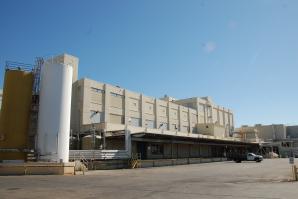The almond cooperative Blue Diamond is the latest major brand to announce that it will be closing its Sacramento location, opting to consolidate packing and manufacturing operations in its Turlock and Salida plants. In a press release from early June, CEO Kai Bockmann stated that “the challenges of running a plant from these historical buildings has become too costly and inefficient.” Accordingly, 2027 will mark the year that Blue Diamond leaves Sacramento after almost 120 years.
The Blue Diamond Growers sign outside the corporate campus in
Sacramento in 2018. (Shutterstock photo)

Campbell’s Soup left its Sacramento plant back in 2013 for similar reasons, stating in a press release that the historic building was home to “the oldest (plant) in Campbell’s U.S. network and has the highest production costs on a per-case basis.”
To be sure, maintenance costs in these historic sites are higher than in other buildings. The California Historic Building Code lays out stipulations and regulations for how buildings must be repaired when necessary. Further, due to the age of these structures, maintenance and repairs are required much more frequently.
Thus, from a business perspective, it makes sense that companies would want to avoid these historic buildings. Modern sites require less maintenance and have fewer restrictions on things like style and materials.
Yet, for all of this increased difficulty, Sacramento’s historic districts are home to many thriving businesses. Gunther’s Ice Cream has proudly stood in Curtis Park since 1940. Back Door Lounge has been situated in its current location since 1968, making it Sacramento’s oldest lounge bar. Countless other cafes, candy shops, galleries and museums litter the districts, most of them small businesses with just one or two locations. These small, locally owned businesses are dominating these areas, while large corporations are closing up shop.
While things like maintenance costs appear to be the main issue driving companies like Blue Diamond and Campbell’s out of Sacramento’s historic districts, the City has taken many steps to mitigating the burden as much as possible for the businesses that do remain.
Campbell’s Soup left its Sacramento plant back in 2013. (Photo
courtesy of Rabin Worldwide)

William Burg, historian and president of Preservation Sacramento, says that there are many incentives geared toward keeping businesses in these historic structures. Indeed, according to Burg, the California Historic Building Code is, in itself, a type of incentive for property owners. It is easy to think of a bill by this title as more restrictive than ordinary building code, but Burg says this is not the case.
The bill was adopted as a way to keep property owners from having to take on large renovations or demolish buildings entirely, simply because the buildings do not live up to some of the smaller details of current code. He argues, for example, that there is no reason these buildings should be torn down because the primary entryway is not as wide as modern code would demand.
Further, when a historic building is in need of renovations, through the Mills Act, a 20 percent income tax credit is available at the federal level to owners of “income-producing” structures. At the California state level, owners can receive a tax credit of 20-25 percent of the cost of renovations (depending on certain criteria).
All of this is designed to alleviate the burden of higher maintenance costs, so that owners can focus their resources on upkeep and maintenance of their property. On top of all of this, according to Burg, rent is generally cheaper for buildings on the Sacramento register, and property taxes go down by roughly 33 percent.
All of these policies are business-friendly and help owners of historic commercial and residential real estate manage the costs associated with owning old buildings. However, this still does not explain why small businesses are thriving, where larger ones are failing.
The answer is not in size, at least, not inherently. An important note about most of the businesses setting up shop in Sacramento’s historic districts is that they are customer-facing. Companies like Gunther’s Ice Cream and Back Door Lounge are able to trade on the ambiance that comes with operating in an historic building. The reason they are able to thrive is the same reason speakeasies have reemerged in recent years.
The beloved “Jugglin’ Joe” atop Gunther’s, the juke box in Back Door Lounge and the Delta King Hotel operating out of a riverboat all hearken back to a simpler time. For a few moments out of your day, the hustle of a world spinning at break-neck speed seems to melt away. These little charms are not necessary to running these establishments, but they are enjoyed more because of them.
The Delta King hotel floats at the dock in Old Sacramento in
2019. (Shutterstock photo)

This slower, old-timey atmosphere is much easier for customer-facing businesses to embrace. Corporations like Blue Diamond and Campbell’s Soup have to go out of their way to try to capitalize on the beauty of historic architecture. Of course, it is not impossible. Blue Diamond, for example, used to offer tours of their location.
But this is an added expense, another project that needs dedicated managers, employees, resources and line items in the budget. For customer-facing companies, the style and beauty of the historic designs is a built-in attraction that only requires upkeep, capitalizing on these advantages only requires being present.
But why are small businesses still thriving? Why is there not an influx of large, customer-facing companies taking over these spots? The simple answer is the added character. A large part of why anyone eats out instead of cooking at home is the experience. For this reason, a large chain like Ruth’s Chris demands uniformity in atmosphere across all of its locations. Having a consistent brand means delivering a consistent experience. This, by and large, is not feasible when attempting to incorporate an historic location into the chain.
However, small, one-location companies do not have this issue. Brand consistency is simply a matter of training employees and embracing the charm already baked into the building. In short, small businesses more easily thrive in historic buildings because they are best suited to take advantage of the benefits these buildings offer. An almost fully-crafted brand image is already built into the historicity of the building, and when there is no need to unify that image across multiple locations built in different time periods under different architectural philosophies, a business is free to embrace what is handed to it.
It is this combination of small, locally owned businesses, and customer-facing industries that allows so many companies to call these districts home. For this reason, historic buildings in Sacramento, and all across California, have, and will continue to be, places for small businesses to thrive.
Michael Reynosa, a resident of Roseville, is a professional diesel technician who has spent the majority of his life with and around farmers.
–
Stay up to date on business in the Capital Region: Subscribe to the Comstock’s newsletter today.
Recommended For You

How ‘Sewer Credits’ Are Bringing New Life to the Old Campbell Soup Manufacturing Plant
A first-of-its-kind credit program is helping to fund the
redevelopment of a former soup factory in south
Sacramento.

The Way We Work: Mark Jansen
A glimpse into the daily life of Blue Diamond CEO Mark Jansen
Each issue, we dig into the working habits of a top executive in the Capital Region, providing insight into how they get things done.

Safeguarding Sacramento’s Historic Architecture
Architects, preservationists and historians work together to adaptively reuse Sacramento’s historic resources
Preservation projects are being embraced in the Capital
Region in an effort to preserve history and protect the
environment.

Working to Preserve Sacramento’s Architecture
Preservation Sacramento is a nonprofit organization dedicated to protecting the city’s historic places, and The Hive — Sacramento’s largest coworking community — recently expanded into a 15,000-square-foot space at the historic Cannery, which has been redeveloped into a business park.



